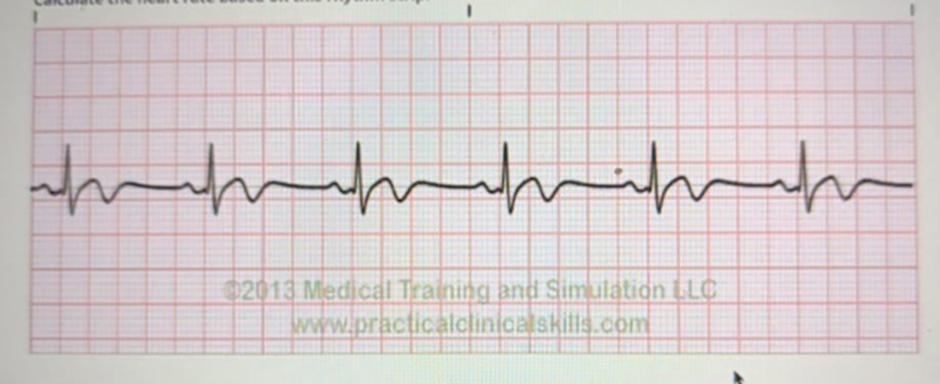Calculate the heart rate based on this rhythm strip.

60
100
90
75
The Correct Answer is A
To calculate the heart rate based on the rhythm strip, we can use the "six-second method".
Count the number of QRS complexes in a six-second strip.
Multiply this number by 10.
In this case, it appears that there are approximately 6 QRS complexes in a six-second strip.
Therefore, the heart rate is approximately 6 x 10 = 60 beats per minute.
Nursing Test Bank
Naxlex Comprehensive Predictor Exams
Related Questions
Correct Answer is D
Explanation
Correct Answer: D. Stage 1 hypertension
Rationales
A. Within the expected reference range.
Normal blood pressure is defined as a systolic less than 120 mm Hg and a diastolic less than 80 mm Hg. Since this client’s reading is 130/82 mm Hg, it exceeds the normal range, so it cannot be classified as expected.
B. Elevated.
Elevated blood pressure is defined as systolic 120–129 mm Hg and diastolic less than 80 mm Hg. While the systolic pressure of 130 is only slightly above this range, the diastolic value of 82 exceeds the “less than 80” requirement. Therefore, this reading does not qualify as elevated.
C. Stage 2 hypertension.
Stage 2 hypertension is defined as systolic pressure of 140 mm Hg or higher or diastolic pressure of 90 mm Hg or higher. This client’s values do not meet those thresholds, so stage 2 does not apply.
D. Stage 1 hypertension.
Stage 1 hypertension is defined as systolic 130–139 mm Hg or diastolic 80–89 mm Hg. Since the client’s reading is 130/82 mm Hg, both values fall within this category, making stage 1 hypertension the correct classification.
Correct Answer is B
Explanation
A) Troponins: These are primarily used to assess for cardiac damage, such as in myocardial infarction. They are not directly related to the effects of spironolactone, so monitoring troponins is not necessary in this context.
B) Potassium: Spironolactone is a potassium-sparing diuretic, which can lead to elevated potassium levels (hyperkalemia). This can have serious implications, including cardiac arrhythmias. Therefore, it is crucial to monitor potassium levels regularly in clients taking
spironolactone to prevent potential complications.
C) Albumin: While albumin levels can provide information about the client's nutritional status and liver function, they are not specifically affected by spironolactone. Monitoring albumin is not a priority when considering the use of this medication.
D) Bicarbonate: Bicarbonate levels are important for assessing acid-base balance. Although spironolactone may have some impact on acid-base status, monitoring bicarbonate is not as critical as monitoring potassium levels, which are directly affected by the medication's action.
Whether you are a student looking to ace your exams or a practicing nurse seeking to enhance your expertise , our nursing education contents will empower you with the confidence and competence to make a difference in the lives of patients and become a respected leader in the healthcare field.
Visit Naxlex, invest in your future and unlock endless possibilities with our unparalleled nursing education contents today
Report Wrong Answer on the Current Question
Do you disagree with the answer? If yes, what is your expected answer? Explain.
Kindly be descriptive with the issue you are facing.
